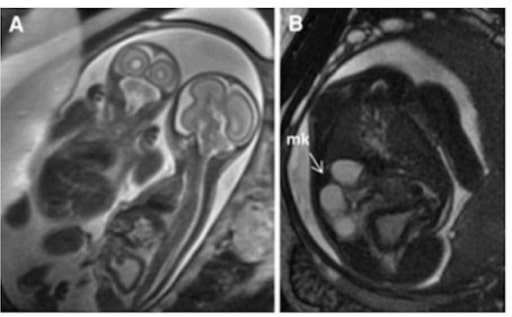Playlist
Show Playlist
Hide Playlist
Unilateral Renal Agenesis
-
Slides CongenitalRenalPathology.pdf
-
Reference List Pathology.pdf
-
Download Lecture Overview
00:01 Now, say that a patient -- a child, excuse me. 00:04 Well, your patient is a child here and he was only born with one kidney. 00:08 One in one thousand, look how common that is. 00:10 So one in one thousand new born infants only have one functioning kidney. 00:16 Is this child gonna die? Thank goodness, no. 00:18 It's bad enough that diseases occur in general but when a disease occurs in a child, not good. 00:24 That doesn't make me feel very good and neither should you, but this a good story. 00:29 So when you have one kidney understand that your patient is going to be working or the kidney function will be quite normal. 00:36 Boys are affected more so than girls, the left kidney is usually the one that is absent. 00:41 Left kidney. Left kidney is a little special, in other ways as well and anatomically. 00:48 Remember, the left kidney, when it wants to drain its blood will be moving through the left renal vein, it is then going to hook up with the left gonadal vein, and for the boy, obviously the left testicular, and then it's going to move on to the inferior vena cava. 01:05 That is not how it works on the right side, is it? The inferior vena cava because it's more proportioned on the right side, you have renal vein that would directly connect with the inferior vena cava so left kidney is rather interesting in that manner. 01:19 We'll talk about a few other issues later on with renal cell carcinoma. 01:23 In this case, the left kidney is absent and much more so. 01:26 Well, what about the other kidney? There's only one left? It undergoes something called compensatory hypertrophy and that's amazing, actually, because even when you do renal transplants, and with renal transplants that kidney is usually left within the patient because it's too difficult to take out because the kidney is retroperitoneal, and you're going to then insert a new kidney from the anterior side and when you do so it's amazing to watch this kidney grow. 01:59 Really, quite fascinating. And so here with unilateral renal agenesis, the body know, the kidney knows and so therefore it will undergo compensatory hypertrophy and performs the function of the missing kidney.
About the Lecture
The lecture Unilateral Renal Agenesis by Carlo Raj, MD is from the course Introduction to Renal Pathology.
Included Quiz Questions
What is the typical response of the solitary kidney in unilateral renal agenesis?
- Compensatory hypertrophy
- Compensatory atrophy
- Compensatory dystrophy
- Compensatory necrosis
- Compensatory hyperplasia
Customer reviews
5,0 of 5 stars
| 5 Stars |
|
5 |
| 4 Stars |
|
0 |
| 3 Stars |
|
0 |
| 2 Stars |
|
0 |
| 1 Star |
|
0 |




